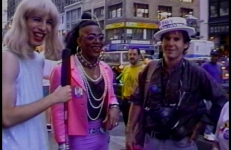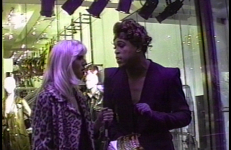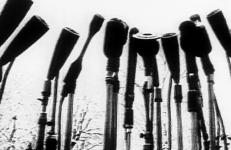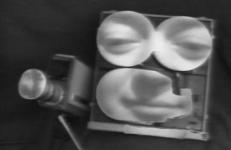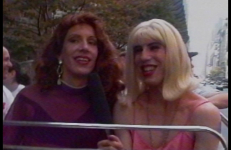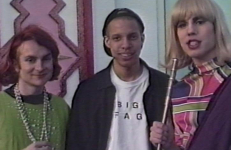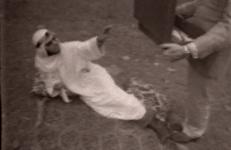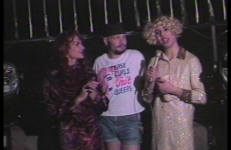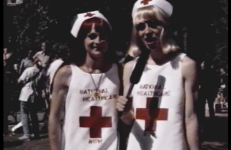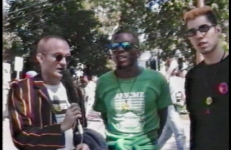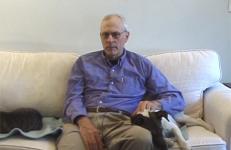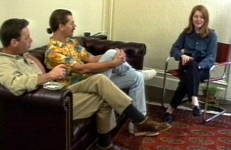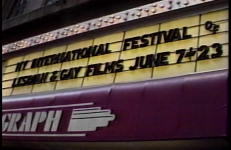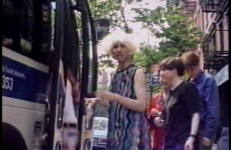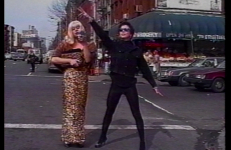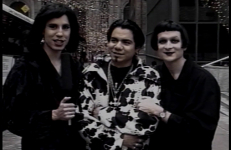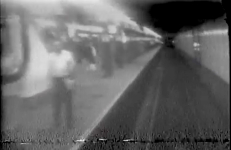In this episode of The Brenda and Glennda Show, Glennda meets up with guest co-host Joan Jett Blakk to discuss Blakk’s 1992 presidential run. The pair interview people on the street outside of the 1992 Democratic Convention. They discuss topics including the police state, weaknesses of the two-party political system, feminism, and political elitism.
TV production
In One Man Ladies, Glennda Orgasm is joined by Vaginal Davis as they meet women on the streets of New York City to discuss Laura Schlessinger's book Ten Stupid Things Women Do to Mess Up Their Lives. The pair humorously explore the best ways modern women can find and secure a husband.
An episode of Glennda and Friends, hosted by Glennda Orgasm and Vaginal Davis.
Presidential candidates are sold like commercial products and naturally television is the ideal medium. Political Advertisement depicts the evolution of political ads over the last 44 years, beginning with Eisenhower in 1952 (which was an unqualified success), and continuing up to the most recent ad campaigns for Ross Perot, Bob Dole, and Bill Clinton in 1996.
Presidential candidates are sold like commercial products and naturally television is the ideal medium. Political Advertisement depicts the evolution of political ads over the last 44 years, beginning with Eisenhower in 1952 (which was an unqualified success), and continuing up to the most recent ad campaigns for Ross Perot, Bob Dole, and Bill Clinton in 1996.
Antonio Muntadas and Marshall Reese have been documenting the selling of the American presidency since 1984, and have expanded and updated the series with every election. Political Advertisement 2000 features ads from the 1950s up to the 2000 campaign. As Muntadas and Reese trace the development of the TV spot, what emerges is the political strategy and manipulative marketing techniques of the American televisual campaign process. Political Advertisement 2000 includes many rare spots, some never before seen.
Antonio Muntadas and Marshall Reese have been documenting the selling of the American presidency since 1984, and have expanded and updated the series with every election. Political Advertisement 2000 features ads from the 1950s up to the 2000 campaign. As Muntadas and Reese trace the development of the TV spot, what emerges is the political strategy and manipulative marketing techniques of the American televisual campaign process. Political Advertisement 2000 includes many rare spots, some never before seen.
This eight-minute video is part experimental video art, part sketch comedy routine, and part informational lesson on the advantages and disadvantages of owning Sony's latest video technology. In it, David and Carol participate in a brilliantly theatrical, seemingly improvisational conversation, in which each one adopts the specific identity and perspective associated with a particular video technology: David plays the part of the Sony Camera AVC 3400, while Carol takes on the personality of the Sony Portapak AV3400.
In Post Queer Pride 93, Brenda and Glennda attend the New York City Queer Pride Parade. This video marks the return of Brenda after her relocation to Florida, and Glennda interviews her about the queer scene and gay activism in the South. At the parade, they conduct interviews with queers about the postqueer movement, the leather and SM scene, feminism, and capitalism.
In Queens on the Media Scene, East Village drag queen Linda Simpson (of My Comrade zine) joins Glennda to discuss the explosion of drag in the mainstream media, and the pair interview passers-by on the streets of Midtown Manhattan. They discuss the rising acceptance of drag in the mainstream, in part due to the media presence of RuPaul; the potential taming of drag or its normalization; and an ambition to preserve the more taboo aspects of drag expression in the face of increasing popularization.
In this episode of The Brenda and Glennda Show, Brenda and Glennda lead a group of drag queens on a trip to Donald Trump’s Taj Mahal Hotel & Casino in Atlantic City. Intended to be a drag queen gambling getaway and a public stage for drag visibilty, the trip turns into a moment of protest and reflection incited by homophobic discrimination. The group is kicked out of the gambling area for supposedly wearing excessive makeup and inapprorpiate, flashy attire — somehow unlike and worse than that of the casino's showgirls and other heavily powdered female patrons.
In this spoof program produced for Lanesville TV, the premise is that a “Sheik” has come to buy all the land in Lanesville. Videofreex member Carol Vontobel reports that the sheik (Bart Friedman), escorted by his real estate agent (Parry Teasdale) is approaching people in the community and asking to buy their homes. An unknown Lanesville local chauffeurs them around, and the Videofreex interview Mr. Benjamin, Mr. And Mrs. Kelly, Mr. Lloyd, Mr. and Mrs. Ginsburg, and others from the Tavern.
In Takeover of the Empire State Building, Brenda and Glennda visit the top of the Empire State Building as it is lit up in lavender for Gay Pride. They interview both tourists visiting the building, and activists who have come to see the lights. Ultimately, they question whether this gesture is adequate, or if there is still a way to go until equality is achieved.
This two-part episode features Glenn Belverio and Duncan Elliott participating in an ACT UP demonstration at President George Bush’s summer house in Kennebunkport, Maine, interviewing activists and documenting this historic event. In addition to this, Brenda Sexual and Glennda Orgasm attend Wigstock, an annual outdoor drag festival in Manhattan's East Village. At the festival, they rally for National Healthcare and discuss other issues such as violence against LGBTQ+ people.
This two-part episode features Glenn Belverio and Duncan Elliott participating in an ACT UP demonstration at President George Bush’s summer house in Kennebunkport, Maine, interviewing activists and documenting this historic event. In addition to this, Brenda Sexual and Glennda Orgasm attend Wigstock, an annual outdoor drag festival in Manhattan's East Village. At the festival, they rally for National Healthcare and discuss other issues such as violence against LGBTQ+ people.
Parry Teasdale is one of the founding members of the video art collective Videofreex, which was active in the 1960s and 70s. In this extensive two-part interview Teasdale explores the collective’s motivations and endeavors, which embodied the social and political concerns of the period.
The Telling (1994-98) shows Anne McGuire telling two acquaintances a secret from her past using a three-camera set-up in the Desi Arnez style. The commodification of intimacy is not the strangest thing about this work. The fractured editing, silences, and lapses in continuity suggest vast narratives far more evocative than anything revealed on screen. McGuire uses television vernacular ambiguously to provoke discomfort, two things that television strives to avoid at all costs.
In this video, Brenda and Glennda attend the opening day of The New Festival (now known as NewFest), a queer film festival in New York City. They interview attendees and filmmakers at the festival to discuss the importance of queer film. Videographer Hans Christian Dany pans back and forth between Brenda and Glennda's interviews and onlookers of the festival, some of whom seem intrigued by the crowd gathering outside the theater, and some who seem offended by the openly queer festival goers.
In this episode of The Glennda and Brenda Show, Glennda and Brenda take over a public bus to protest discrimination and violence against queer people who are "out and outrageous". They pick up many other out and proud friends to stage this queer sit-in.
Interspersed with clips of Judy Garland films and televised concerts, Glennda Orgasm and Judy LaBruce (Bruce LaBruce's Garland inspired drag persona) travel to the West Village to "discover their gay roots". They discuss the current state of queer culture with people attending gay bars and patroning queer businesses, with a cameo from Sadie Benning. They discuss the idea of the post-queer movement, and give guests a "post-queer quiz".
An episode of Glennda and Friends, hosted by Glennda Orgasm and Judy LaBruce.
In Two-Spirits Speak Out, Brenda and Glennda interview members of We'Wah and Bar-Chee-Ampe, one of the first Two-Spirit Native American organizations in New York. This episode addresses gender identity among Two-Spirit people, and discusses their involvement and experiences within the queer community in New York City.
This early Videofreex production exemplifies the type of imaginative approach that the collective adopted when exploring the medium of video, and how, in many ways, this balance of play and experimentation defined and unified the group's work from the very start.




